The New Ford Focus St 2019
► First drive in the new Ford Focus ST
►As fast as a Focus RS in a straight line
►On sale now priced from £29,495
The previous-generation Ford Focus ST was a polarising car. Some people loved its gargling engine note and pin-sharp steering (we're in that camp), but just as many didn't get on with its penchant for torque-steer, loud styling and tough ride quality.
Ford Focus ST: What's new?
Let's start under the bonnet, with the most powerful engine yet fitted to a Focus ST. While the previous petrol ST had a 2.0-litre engine, the new car uses a retuned version of the 2.3-litre four-cylinder Ecoboost engine used in the recently retired (and not to be replaced) Focus RS.
It offers 276bhp and 310lb ft (compared with 247bhp and 266lb ft in the previous petrol ST, so it's a sizeable jump). Anti-lag is new for the Focus ST, too. There's also an electronically controlled limited-slip differential (e-LSD for short) and electronically controlled adaptive dampers (CCD in Ford-speak, for Continuously Controlled Dampers).
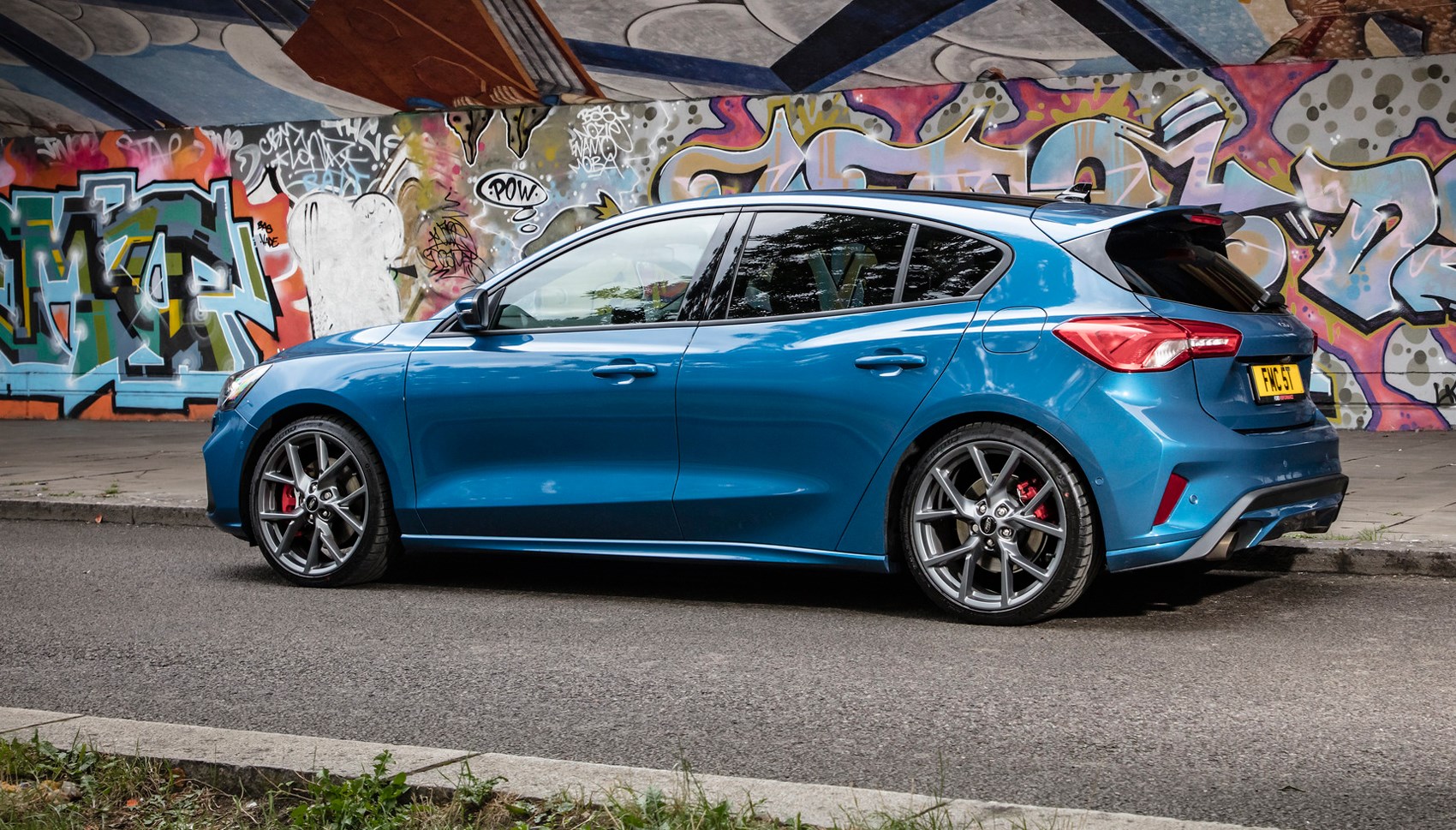
According to Ford Performance's European boss Leo Roeks, the front-drive ST has mid-range in-gear acceleration quicker than the AWD Focus RS, thanks to lighter weight and different gear ratios, with comparable quarter-mile times. Zero to 62mph comes up in 5.7sec, eight tenths quicker than the old ST.
What engines are there? Is there still a diesel and an estate version?
Yes, to both. The diesel is a 2.0-litre with 187bhp and 295lb ft. While the petrol ST gets a choice of a six-speed manual or a seven-speed auto gearbox with paddleshift (although not until later in 2019), the diesel is manual only – which seems odd on the face of it, given its stated remit as the easier-going, big-miles option in the range.
The manual gearbox has a 7% shorter throw than the previous ST's already snappy shift, and features a flat-shift capability – smoothing and maintaining the engine's torque delivery if you keep your foot in while changing up (although not recommended for every upshift) – and automatic rev-matching on downshifts in cars equipped with the optional Performance Pack.
The Estate version is not fitted with the adaptive dampers – they don't fit with the architecture of its rear deck – but does get its own specific tuning for its rear suspension to give the best mix of agility while loaded and unloaded.
What's the interior like?
Generally quite demure, with a light smattering of ST badges on the flat-bottomed steering wheel and on the Recaro seats' backrests to remind you it's a hot hatch, along with some faux carbon trim pieces similar to those of the Fiesta ST.
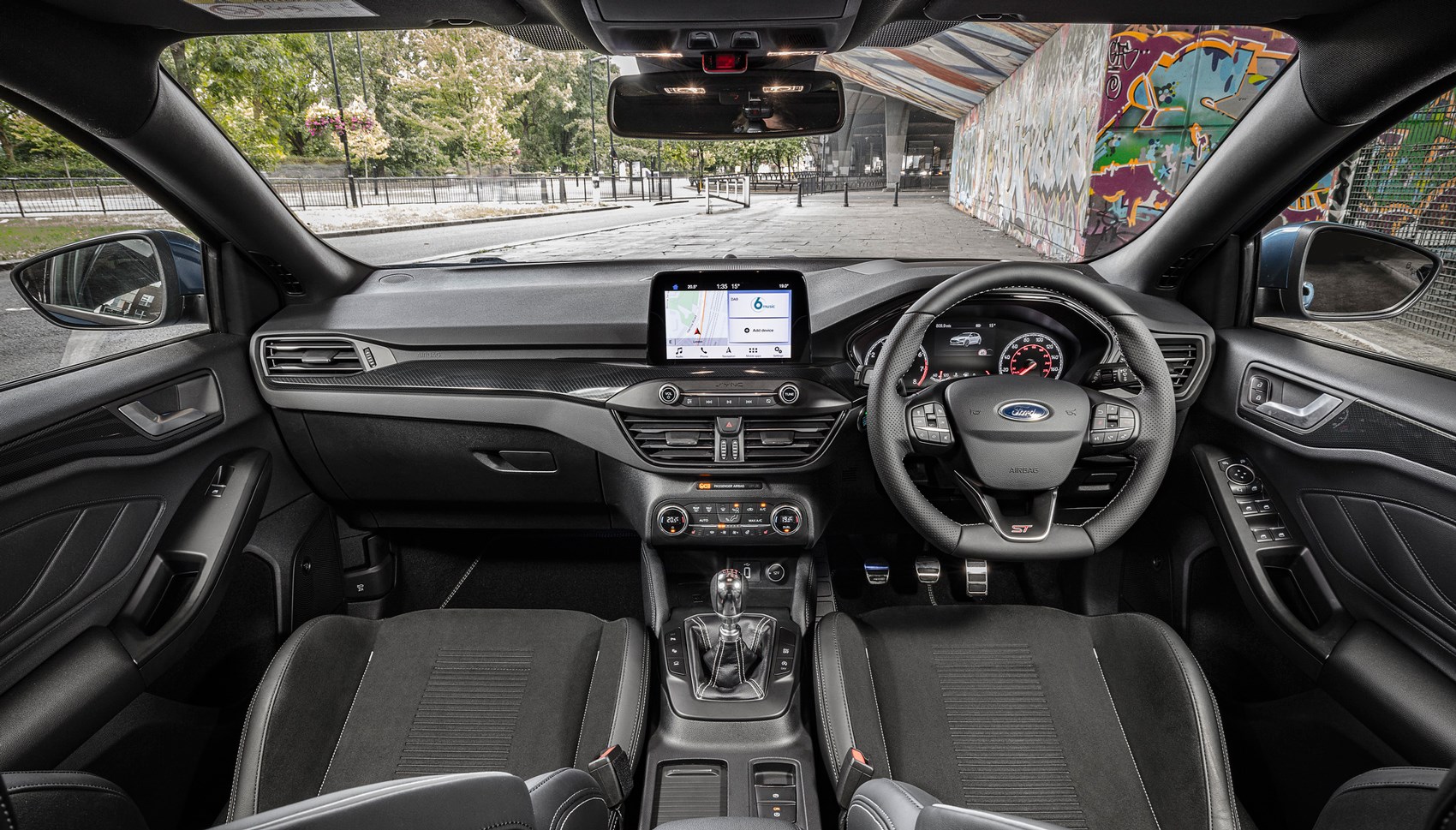
The eight-way adjustable Recaros, trimmed in cloth as standard or leather as an option, are thankfully a bit less overly bolstered than those of the Fiesta ST and the previous Focus ST, with wider space across the shoulders and around the waist so they don't pinch you quite so mercilessly. The base's side bolsters still take some clambering over but overall they're more comfortable and practical than before.
How does the petrol drive?
The Focus ST's acceleration certainly feels as quick as Ford's figures suggest. It stops well, too. The brakes have been made bigger and stronger than previously, with 330mm/302mm discs front/rear, performance pads and an electronic brake booster, constantly adjusting to maintain the pedal's bite when the brakes start getting hot to keep brake feel consistent. With less weight to haul, Ford claims the ST stops better than the Focus RS.
Read our Ford Focus ST long-term test
At Lommel's infamous 'Track 7' handling circuit, one fast left-hand corner is covered in brutally bumpy cobbles, and in its standard driving mode the ST's suspension was remarkably composed over them – certainly more so than a bone-shaking Fiesta ST would be, thanks to the Focus's adaptive dampers.
As standard, the dampers have one pre-set mode, but if buyers opt for the extra-cost Performance Pack they have three pre-set modes to choose from: Normal, Sport and Track.
(The Pack also adds automatic rev-matching on downshifts, and launch control as well as cosmetic tweaks in the form of red brake calipers and multi-coloured interior ambient lighting.)
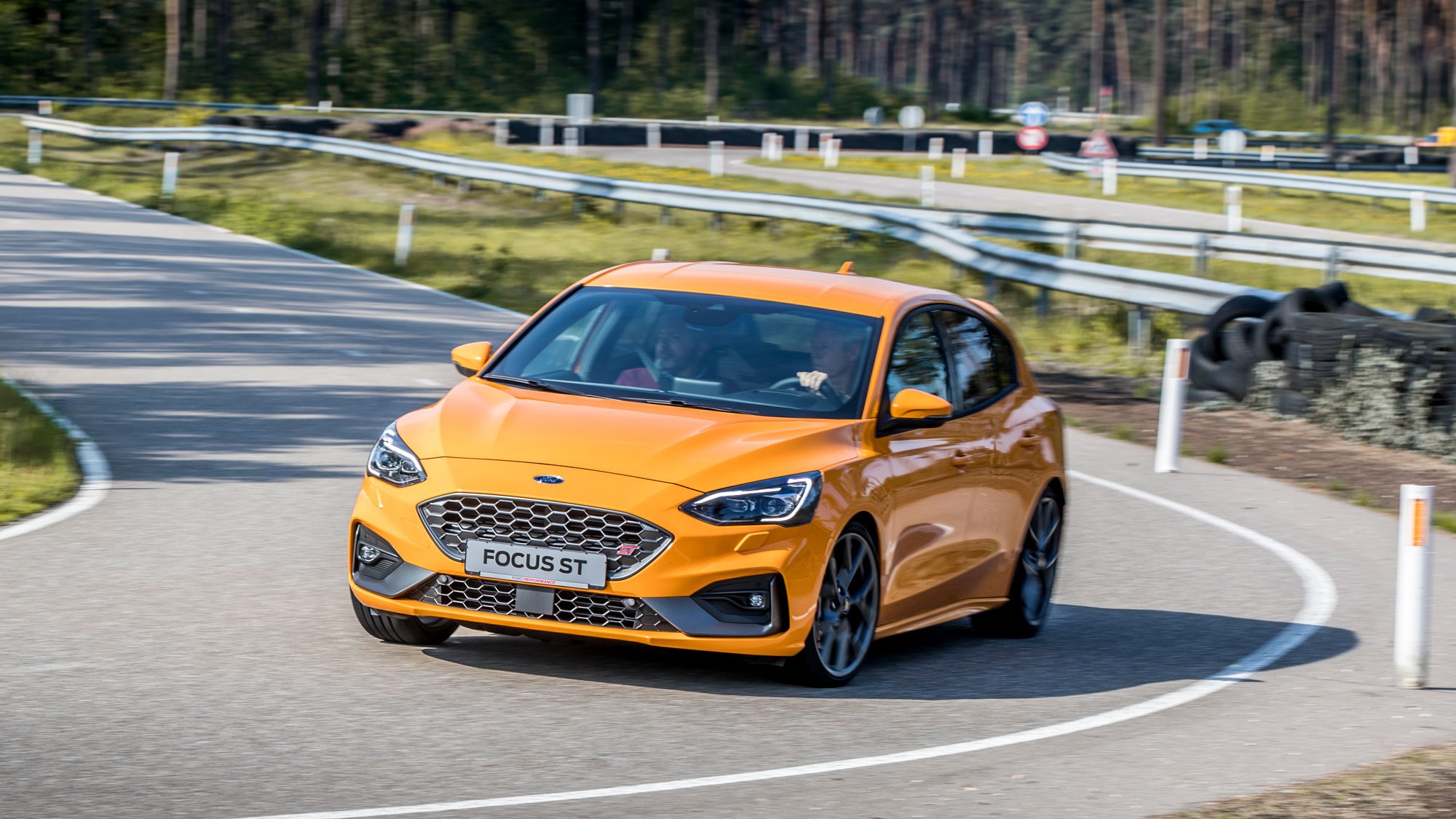
The difference in damping switching through the modes is like night and day. On Lommel's 'Route 14' – a tortuously bumpy winding path modelled to replicate genuine B-roads from different parts of the UK, in their gnarliest form – the suspension is acceptable in Normal mode, but far firmer in Sport and Race.
Back on Track 7, there's a big difference in handling too. Lift your foot from the throttle mid-corner in Normal mode and the ESC system subtly prevents any kind of waywardness, keeping the car entirely under control. In Race, the Focus pivots neatly into oversteer, aided by the electronic settings for the stability control, dampers and diff – but it remains safe and controllable.
Likewise there's a big difference in the way the car sounds, with plenty of pops and crackles on the overrun in Sport, much like the now-deceased Focus RS. As is becoming standard practice throughout the performance car industry, the engine's sound is enhanced using the car's speaker system, taking the natural frequencies of its engine note and amplifying them – bassier at low revs, with a more aggressive edge at higher revs. It works to a degree, but the more natural notes of a Hyundai i30N will satisfy the purists out there a little more.
And that torque-steer is all but banished. It has been reduced by a system linked to both the e-LSD and the electric power steering which applies counter-torque (not counter-steering) to keep the steering calm under power. It's a system already present in the Fiesta ST, and it works well in the Focus.
Also like the Fiesta, the Focus ST has an extremely fast steering rack – even faster, in fact at two turns lock-to-lock. But with a longer wheelbase than the Fiesta, the overall response is said to be comparable.
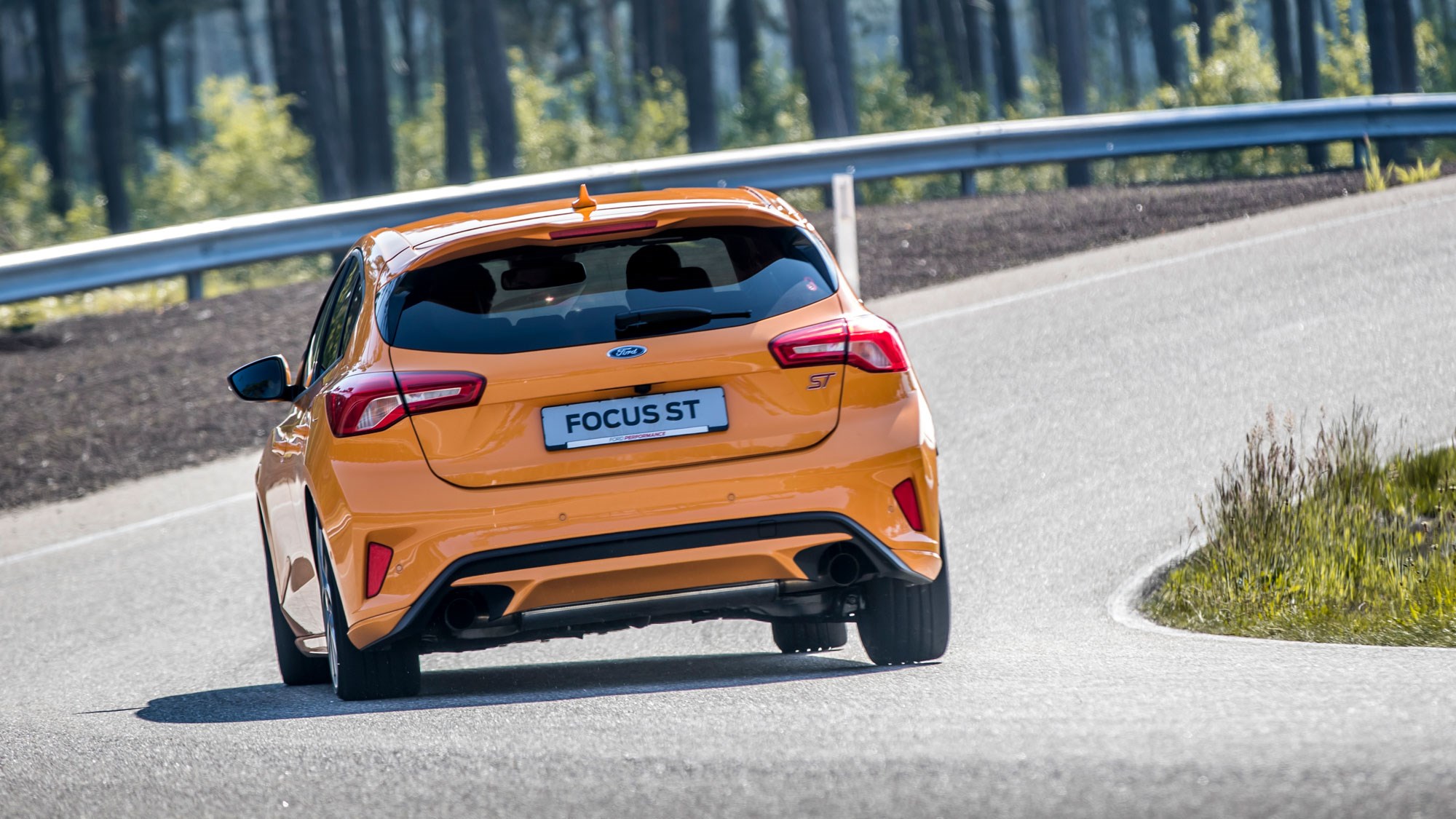
What about the diesel?
Calling it an ST might be a bit of a stretch, but it looks identical to the petrol versions inside and out – the only difference being the lower redline on the rev counter and the exhaust arrangement (petrol versions have two fat cans at the rear, diesels have an offset pair.
The 187bhp black-pump-sipper isn't available elsewhere in the range, so there's a bit of exclusivity there, with on-paper sprint times logged around two seconds slower than the petrol (0-62mph in 7.6sec for the diesel hatch, 7.7sec for the diesel).
The diesel uses the same sound enhancements as the petrol, injecting a bit of spice in Normal and Sport modes (the diesel does without Track). The engine note comes close to completely shrouding an already quiet engine.
Acceleration in the diesel Ford Focus ST is smooth and without a massive lump of torque in the middle, but there's a vibe-killing, pillowy soft limiter that you slowly fall into as you reach the redline. The gearing is also tremendously long compared to the petrol, designed to stretch out fuel economy figures.
What's the diesel ST estate like?
Disappointing, in a word. On paper it's the best of all words: diesel economy, estate practicality and nimble dynamics. In reality, none of that quite works.
The estate practicality is the least contentious issue here. The Focus isn't massive – not as roomy at the Peugeot 308, for instance – but you get usefully more space than in the ST hatch: 370 litres extra with the rear seats down, 302 litres with them up.
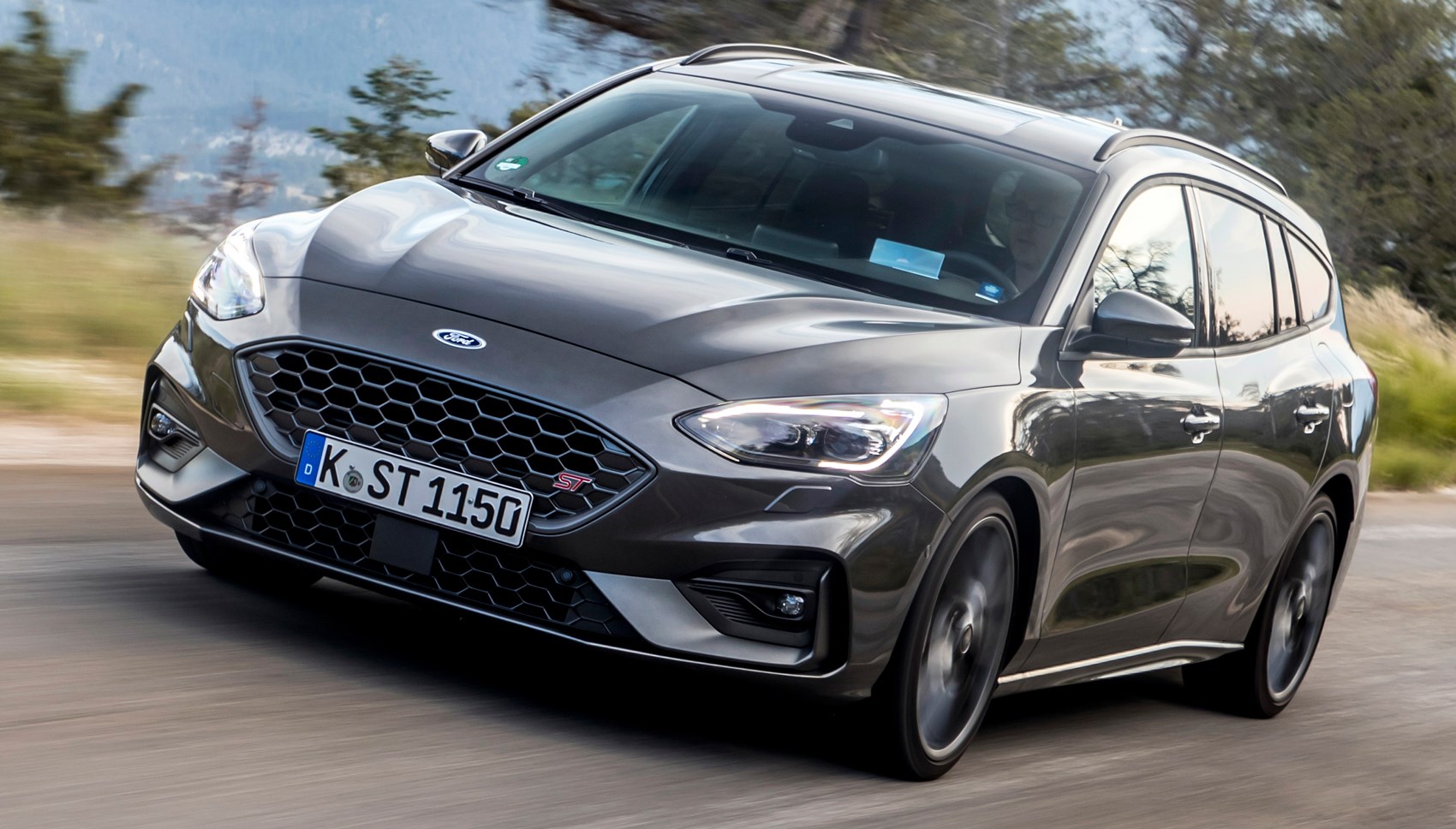
The diesel engine is okay, and the mpg and CO2 figures are healthier than in the petrol ST estate, but you also lose out on top speed and acceleration. If you're after an estate that provides hot hatch thrills – and what else would you want from a wagon badged ST? – this performance shortfall is a problem.
But not as big a problem as the relatively heavy, dithery feel through the bends. Turns out you can't change the rear suspension and lose the e-differential and expect the estate to handle with the agility of the hatch. It's not terrible by any means, but fails to live up to its billing.
If you really want a diesel-engined Focus estate, the best one to go for is the ST-Line, which is slower than the ST, but also cheaper and blessed by a powertrain/chassis combo that's working in much closer harmony.
What's the price?
At launch, the diesel five-door starts at £29,495, extending to £31,995 for the petrol. The estate version costs £30,595 and £33,095 for the diesel and petrol versions, respectively. Auto prices will be confirmed later this year.
That's quite a toppy price, especially when the harder-core but brilliant Honda Civic Type R starts at a few hundred pounds less at the time of writing, and the also excellent Renault Megane R.S. and Hyundai i30 N start from a few thousand pounds less. Ford's defence is that there's no ST-1, ST-2 and ST-3 grades now, so the standard car essentially comes in fully loaded, range-topping trim.
One subjective question is whether the Focus ST looks dramatic enough to turn buyers heads. Although there's a very bright 'Orange Fury' launch colour, in more ordinary hues the Focus looks relatively demure, certainly more so than previous Fast Fords – either a good thing or a bad thing depending on your point of view.
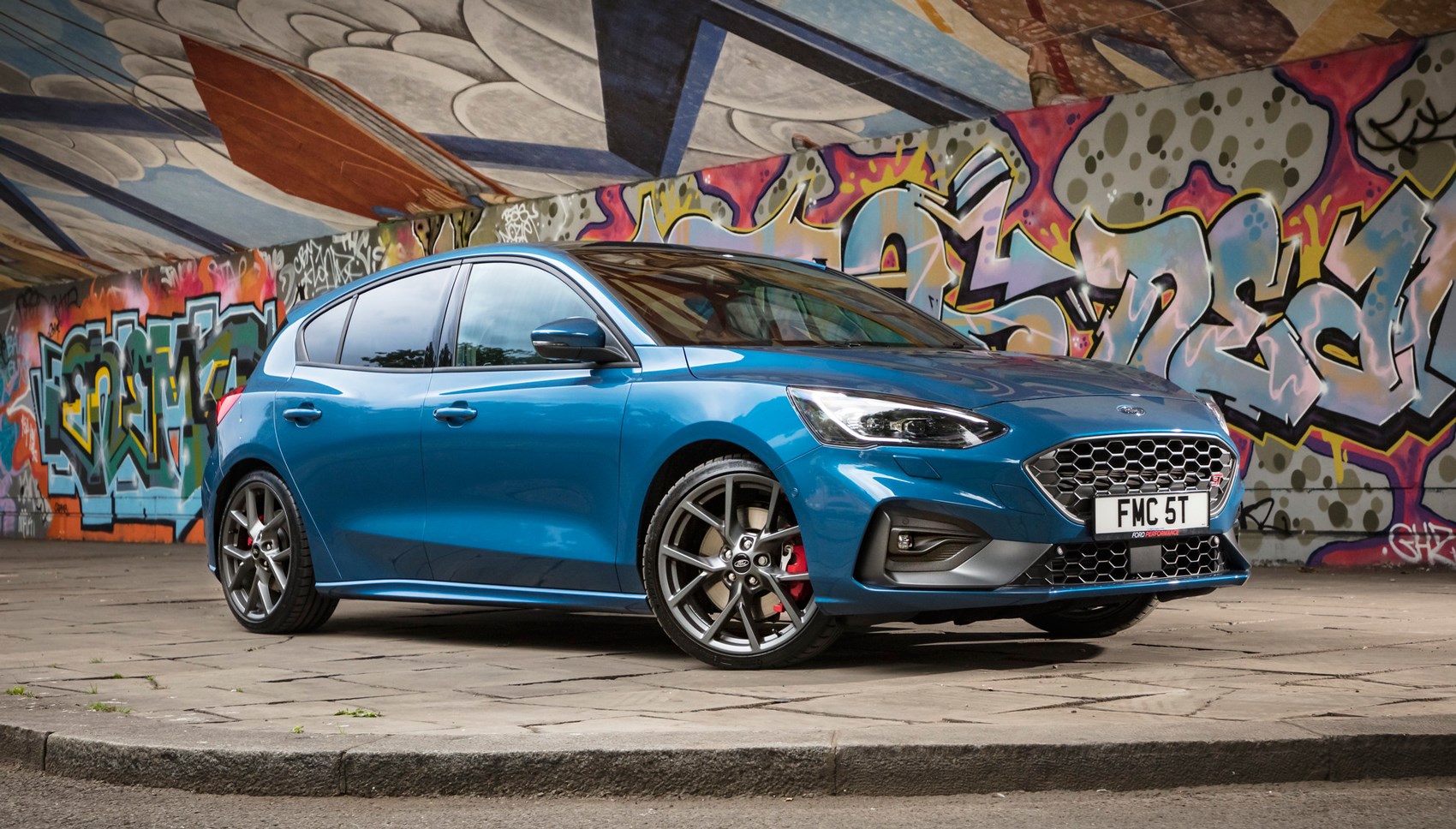
Ford Focus ST: overall verdict
Ford's efforts with the new Focus ST have largely paid off. It's not quite potent enough to worry the superhatch-baiting Civic Type R, but it'll go toe-to-toe with the Megane R.S. and Golf GTI and come out mostly unscathed, as it really can thrill on a good road and rewards you for working with it.
The ride is only just acceptable in Normal mode and it's now quite a pricey beast, but this latest generation of Focus ST is one you should pay attention to; it punches hard, will really entertain if you work it hard and is loaded with kit.
Source: https://www.carmagazine.co.uk/car-reviews/ford/focus-st/
